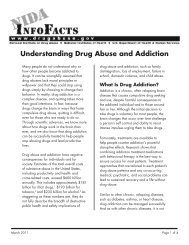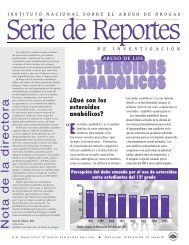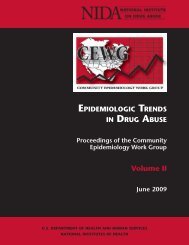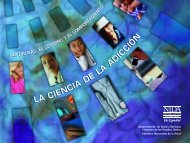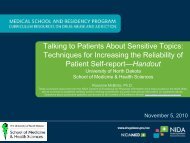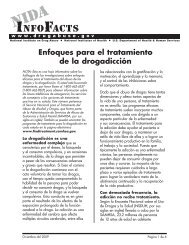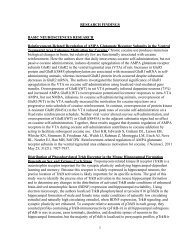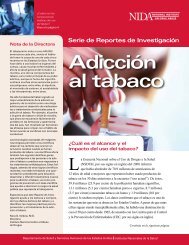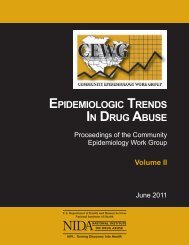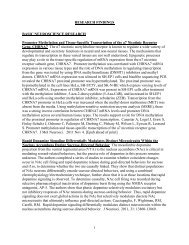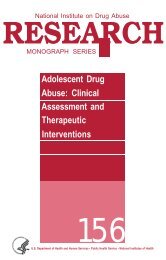CEWG January 09 Full Report - National Institute on Drug Abuse
CEWG January 09 Full Report - National Institute on Drug Abuse
CEWG January 09 Full Report - National Institute on Drug Abuse
Create successful ePaper yourself
Turn your PDF publications into a flip-book with our unique Google optimized e-Paper software.
EpidEmiologic TrEnds in drug AbusE: HigHligHTs And ExEcuTivE summAry<br />
• In Detroit, hydrocod<strong>on</strong>e pois<strong>on</strong> c<strong>on</strong>trol center<br />
calls have increased over the period from 2000<br />
to 2008, with recent increases in numbers of<br />
human intenti<strong>on</strong>al exposure calls, from 526 in<br />
2005, and 516 in 2006, to an estimated 568 in<br />
2008. Oxycod<strong>on</strong>e calls showed signs of declining<br />
in the 2007–2008 period, while methad<strong>on</strong>e<br />
calls increased (figure 6).<br />
• Indicators for prescripti<strong>on</strong> drug abuse in Atlanta<br />
were low and stable. Philadelphia and New York<br />
City had mixed and low indicators, but prescripti<strong>on</strong><br />
drugs were widely available <strong>on</strong> their<br />
streets. Although still low in Los Angeles, indicators<br />
for prescripti<strong>on</strong> narcotics were reportedly<br />
increasing. Similarly, the Denver area member<br />
reported an increase in the use of “other opiates”<br />
since previous reporting periods.<br />
• In Seattle, prescripti<strong>on</strong>-type opiates c<strong>on</strong>tinued<br />
as the most comm<strong>on</strong>ly identified drug in fatal<br />
overdoses and unweighted DAWN ED reports.<br />
The San Francisco <str<strong>on</strong>g>CEWG</str<strong>on</strong>g> member reported an<br />
increase in proporti<strong>on</strong>s of hydrocod<strong>on</strong>e and<br />
oxycod<strong>on</strong>e in unweighted DAWN ED reports<br />
in the coastal counties of the reporting area, but<br />
no increase in the inland counties.<br />
• Treatment admissi<strong>on</strong>s for prescripti<strong>on</strong> narcotic<br />
analgesics were reported as <strong>on</strong> the rise in the<br />
Minneapolis/St. Paul area.<br />
• Indicators for prescripti<strong>on</strong> narcotic analgesics<br />
have stabilized in St. Louis after an increase in<br />
the previous reporting period. However, there is<br />
anecdotal c<strong>on</strong>cern about an increase in the use<br />
of prescripti<strong>on</strong> narcotics in rural areas around<br />
St. Louis. Indicators for other opiate abuses<br />
were down in Hawai‘i and Detroit, and the Bost<strong>on</strong><br />
area member reported stable indicators.<br />
• In several <str<strong>on</strong>g>CEWG</str<strong>on</strong>g> areas, including Seattle,<br />
Detroit, Denver, and Atlanta, ethnographic,<br />
community outreach and other data sources<br />
identified the combined use of prescripti<strong>on</strong><br />
opioids, such as oxycod<strong>on</strong>e and heroin, or the<br />
Figure 6.<br />
Number of Pois<strong>on</strong> C<strong>on</strong>trol Center Calls 1 <strong>on</strong> Human Intenti<strong>on</strong>al Use of Oxycod<strong>on</strong>e,<br />
Hydrocod<strong>on</strong>e, and Methad<strong>on</strong>e, Detroit: 2000–2008 Annualized 2<br />
600<br />
500<br />
526 521<br />
568<br />
Number of Calls<br />
400<br />
300<br />
200<br />
251<br />
275<br />
364<br />
401<br />
Oxycod<strong>on</strong>e<br />
Hydrocod<strong>on</strong>e<br />
Methad<strong>on</strong>e<br />
100<br />
0<br />
100<br />
76<br />
29 39 47<br />
60<br />
70<br />
68<br />
8 14 16 22<br />
36 46 44<br />
22<br />
2000 2001 2002 2003 2004 2005 2006 2007 2008<br />
1<br />
New codes were added mid-2001.<br />
2<br />
Annualized for 2008 based <strong>on</strong> <str<strong>on</strong>g>January</str<strong>on</strong>g> through June 2008 data.<br />
SOURCE: Eastern Michigan Pois<strong>on</strong> C<strong>on</strong>trol Center, as reported by Cynthia Arfken at the <str<strong>on</strong>g>January</str<strong>on</strong>g> 20<str<strong>on</strong>g>09</str<strong>on</strong>g> <str<strong>on</strong>g>CEWG</str<strong>on</strong>g> meeting<br />
14<br />
Proceedings of the Community Epidemiology Work Group, <str<strong>on</strong>g>January</str<strong>on</strong>g> 20<str<strong>on</strong>g>09</str<strong>on</strong>g>



